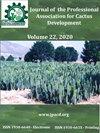枝节的大小和收获时间对刺梨仙人掌粘液的组成和理化稳定性的调节
IF 0.4
4区 农林科学
Q4 HORTICULTURE
Journal of the Professional Association for Cactus Development
Pub Date : 2022-08-30
DOI:10.56890/jpacd.v24i.508
引用次数: 1
摘要
目的是对从不同时间收获的不同大小的枝节中获得的粘液进行物理化学表征。在两个不同的时间(早上6点和晚上8点)收集两种尺寸(100至230毫米和240至300毫米)的胭脂虫Salm-Dyck分支,并进行粘液提取处理。将其在烘箱中干燥,然后水合并在5°C下保持12天。除了红外区主要波段的特征外,还对收获后的粘液产量进行了量化。在粘液中,进行了以下物理化学分析:K+和Na+含量、电导率、可滴定酸度、pH、总酚类化合物、维生素C、总可溶性固体、总可溶性碳水化合物、总可溶性蛋白质,收获后(第0天),以及在5ºC下储存12天。通过主成分分析(PCA)确定变量之间的相关性。在早上6点收获的枝节中,无论大小,都获得了最高的粘液产量。早上6点的收获显示出较高的酸度和蛋白质含量,较低浓度的可溶性固体、EC、Na+、K+、维生素C、碳水化合物和酚类化合物。在保护过程中,大小在100至230毫米之间的枝节的粘液和早上6点的收获表现出更大的稳定性。主成分分析(PCA)显示,在不同的大小、收获时间和保存天数之间有形成群的趋势,表明获得分支的不同条件导致粘液的组成和稳定性存在差异。因此,结果表明,除了其他作者提出的气候条件外,收获时间和枝状茎的大小还调节着理化和重要离子的组成和稳定性,这可以改变粘液的技术和工业应用。本文章由计算机程序翻译,如有差异,请以英文原文为准。
Size and harvest time of cladodes modulate the composition and physicochemical stability of prickly pear cactus mucilage
The objective was to carry out a physicochemical characterization of the mucilage obtained from different sizes of cladodes harvested at different times. Nopalea cochenillifera Salm Dyck cladodes were collected in two sizes (100 to 230 and 240 to 300 mm), at two different times (6 am and 8 pm), and processed for mucilage extraction. This was dried in an oven, and then hydrated and kept at 5 °C for 12 days. The mucilage yield after harvest was quantified, in addition to the characterization of the main bands in the infrared region. In the mucilage, the following physicochemical analyzes were performed: K+ and Na+ content, electrical conductivity, titratable acidity, pH, total phenolic compounds, vitamin C, total soluble solids, total soluble carbohydrates, total soluble proteins after harvest (day 0), and to the 12 days of storage at 5 ºC. Correlation between the variables was determined through principal component analysis (PCA). The highest mucilage yield was obtained in cladodes harvested at 6 am, regardless of size. The 6 am harvest showed higher acidity and protein content and lower concentrations of soluble solids, EC, Na+, K+, vitamin C, carbohydrates, and phenolic compounds. In conservation, the mucilage of the cladodes with sizes between 100 and 230 mm and the harvest at 6 am showed greater stability. Principal component analysis (PCA) showed a tendency of formed groups between different sizes, harvest times, and conservation days, indicating that different conditions for obtaining the cladodes result in differences in the composition and stability of the mucilage. Thus, the results show that, in addition to the climatic conditions, as proposed by other authors, the harvest time and the size of the cladode modulate the physicochemical and important ion composition and stability, which can change the technological and industrial applications of mucilage.
求助全文
通过发布文献求助,成功后即可免费获取论文全文。
去求助
来源期刊

Journal of the Professional Association for Cactus Development
Agricultural and Biological Sciences-Plant Science
CiteScore
1.10
自引率
33.30%
发文量
10
期刊介绍:
The editors of the Journal of the Professional Association for Cactus Development, are very excited to be a part of the excellent editorial committee and to work together to create the synergism between scientists, growers, legislators, and business people so vital to the development of this industry to serve the people of arid lands.
 求助内容:
求助内容: 应助结果提醒方式:
应助结果提醒方式:


